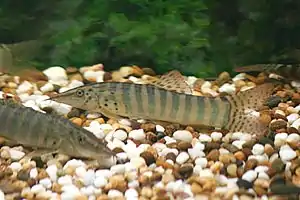Prachtschmerlen
Prachtschmerlen (Botiidae) sind bodenlebende Süßwasserfische aus der Ordnung der Karpfenartigen (Cypriniformes). Alle Prachtschmerlen leben in Süd- und Ostasien von Indien bis China und Japan, sowie auf Sumatra, Java und Kalimantan. Einige Arten sind beliebte Aquarienfische.
| Prachtschmerlen | ||||||||||||
|---|---|---|---|---|---|---|---|---|---|---|---|---|

Prachtschmerle (Chromobotia macracanthus) | ||||||||||||
| Systematik | ||||||||||||
| ||||||||||||
| Wissenschaftlicher Name | ||||||||||||
| Botiidae | ||||||||||||
| Berg, 1940 |
Merkmale
Es sind barbenähnliche, kleine bis mittelgroße, langgestreckte Fische, die oft bunt gefärbt sind. Im Unterschied zu den Steinbeißern (Cobitidae) ist ihr Körper seitlich abgeflacht. Sie haben zwei Paare Rostralbarteln. Die Seitenlinie auf dem Kopf ist auffällig, die Schwanzflosse tief gegabelt. In einer Hauttasche unter jedem Auge liegt jeweils ein Dorn, der durch Muskelbewegungen nach vorn ausgeklappt und mit einem Knochengelenk arretiert werden kann. Das Maul ist unterständig. Die Pharyngealia ist mit einer Zahnreihe besetzt. Prachtschmerlen werden je nach Art 7,8 cm bis einen halben Meter lang.
Äußere Systematik
Die Prachtschmerlen wurden lange Zeit als Unterfamilie Botiinae innerhalb der Steinbeißer geführt. Neuerdings werden sie, basierend auf molekulargenetischen Untersuchungen, als Schwestergruppe der gemeinsamen Klade aus Vaillantellidae, Steinbeißern, Flossensaugern (Balitoridae), Ellopostomatidae und Bachschmerlen (Nemacheilidae) in eine eigene Familie gestellt.

(Botia striata)
Die systematische Stellung verdeutlicht folgendes Kladogramm (nach Bohlen & Šlechtová, 2009,[1] und Chen et al., 2009[2]):
| Karpfenartige (Cypriniformes) |
| |||||||||||||||||||||||||||||||||||||||||||||||||||||||||
Innere Systematik
Die Untersuchung sowohl mitochondrialer als auch nuklearer DNA stützt die Monophylie der Familie. Es sind bisher fast 50 Arten in sieben Gattungen und zwei Tribus beschrieben worden.
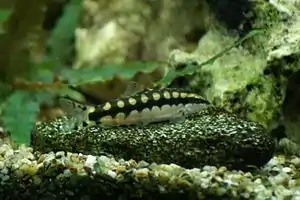
(Ambastaia sidthimunki)

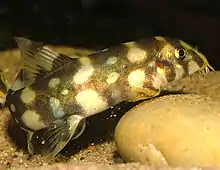
(Botia kubotai)
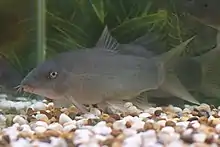
- Prachtschmerlen (Botiidae)
- Tribus Botiini
- Gattung Ambastaia Kottelat, 2012
- Schwarzstreifen-Schmerle, Ambastaia nigrolineata (Kottelat & Chu, 1987)
- Zwergschmerle, Ambastaia sidthimunki (Klausewitz, 1959)
- Gattung Botia Gray, 1831 (Indischer Subkontinent & Birma)
- Netzschmerle, Botia almorhae Gray, 1831.
- Botia birdi Chaudhuri, 1909.
- Grüne Bänderschmerle, Botia dario (Hamilton, 1822).
- Botia dayi Hora, 1932.
- Botia histrionica Blyth, 1860.
- Botia javedi Mirza & Syed, 1995.
- Birma-Prachtschmerle, Botia kubotai Kottelat, 2004.
- Botia macrolineata Teugels, De Vos & Snoeks, 1986.
- Botia pulchripinnis Paysan, 1970
- Leiterschmerle, Botia rostrata Günther, 1868.
- Zebra-Prachtschmerle, Botia striata Narayan Rao, 1920.
- Botia udomritthiruji Ng, 2007
- Gattung Chromobotia Kottelat, 2004
- Prachtschmerle, Chromobotia macracanthus, (Bleeker, 1852)
- Gattung Sinibotia Fang, 1936
- Sinibotia longiventralis (Yang und Chen, 1992)
- Sinibotia pulchra (Wu, 1939)
- Sinibotia reevesae (Chang, 1944)
- Sinibotia robusta (Wu, 1939)
- Sinibotia superciliaris (Günther, 1892)
- Syncrossus Blyth, 1860
- Beauforts Schmerle, Syncrossus beauforti, (Smith, 1931)
- Syncrossus berdmorei Blyth, 1860
- Tiger-Schmerle, Syncrossus helodes (Sauvage, 1876)
- Syncrossus hymenophysa (Bleeker, 1852)
- Syncrossus reversa (Roberts, 1989)
- Gattung Yasuhikotakia Nalbant, 2002 (Stromgebiet des Mekong, des Mae Nam Chao Phraya und des Mae Nam Mae Klong)
- Yasuhikotakia caudipunctata (Taki und Doi, 1995)
- Sonnenschmerle (Yasuhikotakia eos) (Taki, 1972)
- Grüne Prachtschmerle, Yasuhikotakia lecontei (Fowler, 1937)
- Yasuhikotakia longidorsalis (Taki und Doi, 1995)
- Blaue Prachtschmerle, Yasuhikotakia modesta (Bleeker 1864)
- Horas Schmerle, Yasuhikotakia morleti (Tirant, 1885)
- Yasuhikotakia pulchripinnis (Paysan, 1970)
- Yasuhikotakia splendida (Roberts, 1995)
- Gattung Ambastaia Kottelat, 2012
- Tribus Leptobotiini
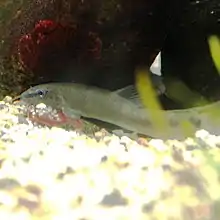 Leptobotia curta
Leptobotia curta- Gattung Leptobotia Bleeker, 1870
- Leptobotia bellacauda Bohlen & Šlechtová, 2016
- Leptobotia curta (Temminck und Schlegel, 1846)
- Leptobotia elongata (Bleeker, 1870)
- Leptobotia flavolineata Wang, 1981
- Leptobotia guilinensis Chen, 1980
- Leptobotia hengyangensis Huang und Zhang, 1986
- Leptobotia mantschurica Berg, 1907
- Leptobotia micra Bohlen & Šlechtová, 2017
- Leptobotia microphthalma Fu und Ye, 1983
- Leptobotia orientalis Xu, Fang und Wang, 1981
- Leptobotia pellegrini Fang, 1936
- Leptobotia posterodorsalis Lan und Chen in Chen und Lan, 1992
- Leptobotia rubrilabris (Dabry de Thiersant, 1872)
- Leptobotia taeniops (Sauvage, 1878)
- Leptobotia tchangi Fang, 1936
- Leptobotia tientainensis (Wu, 1930)
- Leptobotia zebra (Wu, 1939)
- Gattung Parabotia Dabry de Thiersant, 1872
- Parabotia banarescui (Nalbant, 1965)
- Parabotia bimaculata Chen, 1980
- Parabotia brevirostris Zhu & Zhu, 2012
- Parabotia dubia Kottelat, 2001
- Parabotia fasciata Dabry de Thiersant, 1872
- Parabotia lijiangensis Chen, 1980
- Parabotia maculosa (Wu, 1939)
- Parabotia parva Chen, 1980
- Gattung Leptobotia Bleeker, 1870
- Tribus Botiini
Literatur
- Maurice Kottelat: Botia kubotai, a new species of loach (Teleostei: Cobitidae) from the Ataran River basin (Myanmar), with comments on botiine nomenclature and diagnosis of a new genus. Zootaxa. Bd. 401, (9. Januar) 2004, S. 1–18
- Maurice Kottelat: Conspectus cobitidum: an inventory of the loaches of the world (Teleostei: Cypriniformes: Cobitoidei). The Raffles Bulletin of Zoology, Supplementum Nr. 26, 2012, 199 S. (PDF; 5,4 MB)
- Richard L. Mayden, Kevin L. Tang, Robert M. Wood, Wei-Jen Chen, Mary K. Agnew, Kevin W. Conway, Lei Yang, Andrew M. Simons, Henry L. Bart, Phillip M. Harris, Junbing Li, Xuzhen Wang, Kenji Saitoh, Shunping He, Huanzhang Liu, Yiyu Chen, Mutsumi Nishida, Masaki Miya: Inferring the Tree of Life of the order Cypriniformes, the earth’s most diverse clade of freshwater fishes: Implications of varied taxon and character sampling. Journal of Systematics and Evolution. Bd. 46, Nr. 3, 2008, S. 424–438 (PDF, 455 kB)
Einzelnachweise
- Jörg Bohlen, Vendula Šlechtová: Phylogenetic position of the fish genus Ellopostoma (Teleostei: Cypriniformes) using molecular genetic data. Ichthyological Exploration of Freshwaters. Bd. 20, Nr. 2, 2009, S. 157–162 (PDF; 1,8 MB)
- Wei-Jen Chen, V. Lheknim, Richard L. Mayden: Molecular phylogeny of the Cobitoidea (Teleostei: Cypriniformes) revisited: position of enigmatic loach Ellopostoma resolved with six nuclear genes. Journal of Fish Biology. Bd. 75, Nr. 9, 2009 S. 2197–2208, doi:10.1111/j.1095-8649.2009.02398.x
Weblinks
- Prachtschmerlen auf Fishbase.org (englisch)
